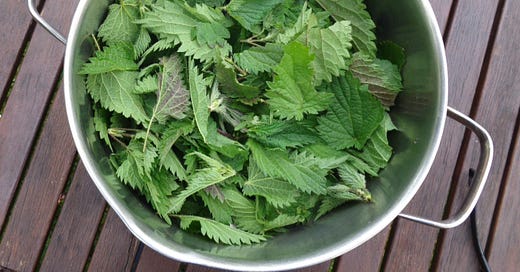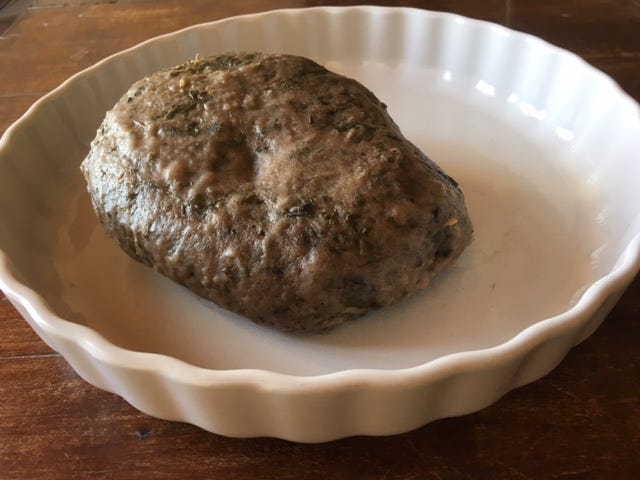Folk names such as ‘Devil’s leaf’ for Urtica dioica tell eloquently of the human difficulty with the plant - the underside of the leaf contains thousands of minute hypodermic syringes. It is these that puncture the skin to inject a chemical cocktail of formic acid, histamine, acetylcholine, serotonin, tartaric acid and oxalic acid causing the pain that gives the plant its most common cognomen, ‘stinging nettle.’ The plant’s scientific name is further confirmation, Urtica being from the Latin, urere, ‘to burn’.
Still, some Stone Age person, either canny or desperate, discovered that nettle leaves when boiled lose their tell-tale sting; nettle pudding is the oldest known dish in the world, first made 8000 years ago. I cooked it myself some years ago while practising what I call ‘Method Writing’, that is living the way of life you are accounting for in words. I was recreating prehistoric England (in a book, Woodston, about the titular farm) and that nettle pudding -a sort of dumpling- remains one of the most satisfying dishes I have ever made or eaten. What the first prehistoric chef discovered with nettles is a superfood on the very doorstep of the British cave: nettles, according to modern scientific studies, contain notable levels of vitamin A (beta-carotene), vitamin C, anti-oxidants, plus iron and calcium. The protein content dry weight is comparable to nuts and fowl. Nettles are also usefully fibrous.
For 8,000 years nettles were a part of our diet. As late as the Victorian era hawkers on streets used to cry, ‘Nettles with tender shoots to cleanse the blood,’ and Scottish miners added nettles to their porridge. Gardeners cultivated them as a spring green, rather than treating them as a weed. (Andrew Fairservice, the gardener in Walter Scott’s Rob Roy, raised them under glass, to get an advance on the season.) Nettles made a soft beer, a country tea. Neither were nettles confined to THE kitchen; nettles made cloth (‘nettle’ , indeed, being likely from proto-Indian-European ‘to bind’) and the optimistic rubbed nettle juice on their heads to cure baldness.
Then nettles fell off the table, as we became more ‘civilised’, divorced from our rural roots, only to become the teat-sucking dependents of processed, value-added food sold by supermarkets. A sort of resurrection for the nettle came in the 1970s with hippie nettle tea, and the vogue for ‘food for free.’
Nettles, as well as being free, are abundant. They grow almost everywhere. They are to be found in gardens, waste ground, woodland edges and fields. Lovers of nitrogen and phosphate, nettles grow best on fertile soils, which explains their particular near impenetrable abundance in farmyards and abandoned houses, particularly the midden and the lavatory. Archaeologists even use the presence of nettles as an indicator of human habitation.
Eating the free ‘weed’ that is the stinging nettle is not only good for purse and health…it’s a small moment of freedom from dependency on Big Food. Also, you are never closer to Nature than when you are foraging it. When you are inside the food chain yourself.
Aside from eating your first foraged fungi, nothing you do with wild food will cause you as much trepidation as eating your first stinging nettles. However, as said, the syringes and toxic concoction are destroyed in cooking, leaving a green vegetable with an earthy flavour reminiscent of slightly bitter spinach. After that, steaming for 4–5 minutes is their easiest preparation, the nettles served up with a knob of butter and squirt of lemon. Like spinach, nettles ‘cook down’, so gather them by the carrier bag full.
Only the young leaves at the top of the plant are to be eaten, partly because they are the most tender, partly because the plant is a rich refuge for insects, especially peacock and small tortoiseshell butterflies. Wear thick rubber gloves and pick the topmost leaves only. Nettles appear in the spring and can be harvested until July. After July the leaves fill with crystals of calcium carbonate which make them grittily unpleasant.
There is more to be done with nettles than simply serving up as a jade green veg. Aside from nettle pudding (see above image) nettles, barley flour, other greens, salt and water) nettles can be made into pesto, soup, quiche. So, grasp the nettle today.
Nettle pesto:
Ingredients
100g nettle leaves
1 clove garlic
50g pine nuts
50g grated Parmesan
10 tbsp extra virgin oil
salt and pepper
Wash the nettles, remove their stem and central vein, and blanch them for 5 minutes. Squeeze them between your hands to remove the water.
Pour the pine nuts into an S-blade food processor, and mix using the pulse function. Add the nettles and crushed garlic, mix again. Finally, add the other ingredients, and mix one last time.
Nettle beer:
Nettle beer is a mildly alcoholic drink, made commercially in Europe, and simplicity itself to make.
Equipment (sterilised before use) fermentation bin, muslin airlock and bung, funnel, siphoning tube, bottles
Ingredients
2kg (4 carrier bags full) of washed young stinging nettle leaves 30g ground ivy (Glechoma hederacea)
9 litres water
Juice of 2 lemons
3kg white sugar
100g cream of tartar
Brewer’s yeast
Boil the nettle tips and ground ivy in the water for 15 minutes. Allow to cool slightly, before straining the dark brown liquid into a sterilised fermentation bin. Add the lemon juice, sugar, cream of tartar and stir well. When the liquid is at room temperature, sprinkle the yeast on top, and cover with a layer of muslin or net curtain, tied so the material does not dip down into the liquid. After twenty four hours remove the muslin, and fit an airlock. Leave for a further five days. Strain into sterile wine bottles and cork loosely. Or you can use old plastic mineral water bottles. Store in a cool dark place for a week. Serve chilled.
More nettle and wild food recipes can be found in my books Foraging: The Essential Guide to Wild Food, 2012 and The Wild Life, 2012






They are excellent fertilizer! Now going to chop them in gnocchi - TY for that :)
Check out this post. Notice anything in the picture? Just a giant patch of wood nettle. Same sting, same taste, same benefits!
https://oldhollowtree.substack.com/p/that-old-wheel-keeps-turning